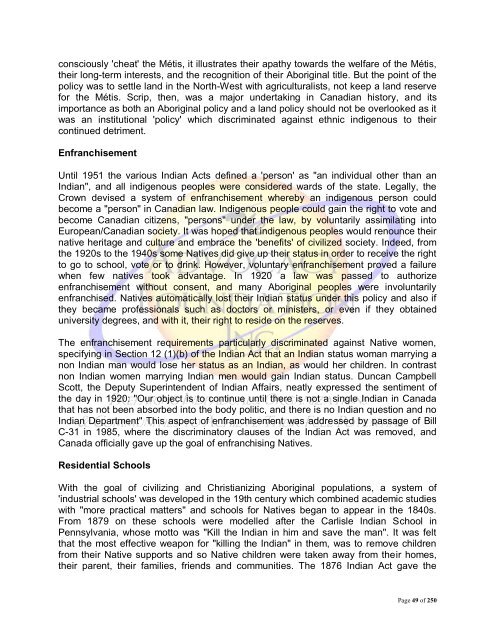Institutional Racism
Institutional Racism
Institutional Racism
You also want an ePaper? Increase the reach of your titles
YUMPU automatically turns print PDFs into web optimized ePapers that Google loves.
consciously 'cheat' the Métis, it illustrates their apathy towards the welfare of the Métis,<br />
their long-term interests, and the recognition of their Aboriginal title. But the point of the<br />
policy was to settle land in the North-West with agriculturalists, not keep a land reserve<br />
for the Métis. Scrip, then, was a major undertaking in Canadian history, and its<br />
importance as both an Aboriginal policy and a land policy should not be overlooked as it<br />
was an institutional 'policy' which discriminated against ethnic indigenous to their<br />
continued detriment.<br />
Enfranchisement<br />
Until 1951 the various Indian Acts defined a 'person' as "an individual other than an<br />
Indian", and all indigenous peoples were considered wards of the state. Legally, the<br />
Crown devised a system of enfranchisement whereby an indigenous person could<br />
become a "person" in Canadian law. Indigenous people could gain the right to vote and<br />
become Canadian citizens, "persons" under the law, by voluntarily assimilating into<br />
European/Canadian society. It was hoped that indigenous peoples would renounce their<br />
native heritage and culture and embrace the 'benefits' of civilized society. Indeed, from<br />
the 1920s to the 1940s some Natives did give up their status in order to receive the right<br />
to go to school, vote or to drink. However, voluntary enfranchisement proved a failure<br />
when few natives took advantage. In 1920 a law was passed to authorize<br />
enfranchisement without consent, and many Aboriginal peoples were involuntarily<br />
enfranchised. Natives automatically lost their Indian status under this policy and also if<br />
they became professionals such as doctors or ministers, or even if they obtained<br />
university degrees, and with it, their right to reside on the reserves.<br />
The enfranchisement requirements particularly discriminated against Native women,<br />
specifying in Section 12 (1)(b) of the Indian Act that an Indian status woman marrying a<br />
non Indian man would lose her status as an Indian, as would her children. In contrast<br />
non Indian women marrying Indian men would gain Indian status. Duncan Campbell<br />
Scott, the Deputy Superintendent of Indian Affairs, neatly expressed the sentiment of<br />
the day in 1920: "Our object is to continue until there is not a single Indian in Canada<br />
that has not been absorbed into the body politic, and there is no Indian question and no<br />
Indian Department" This aspect of enfranchisement was addressed by passage of Bill<br />
C-31 in 1985, where the discriminatory clauses of the Indian Act was removed, and<br />
Canada officially gave up the goal of enfranchising Natives.<br />
Residential Schools<br />
With the goal of civilizing and Christianizing Aboriginal populations, a system of<br />
'industrial schools' was developed in the 19th century which combined academic studies<br />
with "more practical matters" and schools for Natives began to appear in the 1840s.<br />
From 1879 on these schools were modelled after the Carlisle Indian School in<br />
Pennsylvania, whose motto was "Kill the Indian in him and save the man". It was felt<br />
that the most effective weapon for "killing the Indian" in them, was to remove children<br />
from their Native supports and so Native children were taken away from their homes,<br />
their parent, their families, friends and communities. The 1876 Indian Act gave the<br />
Page 49 of 250

















